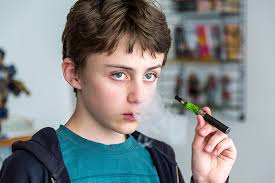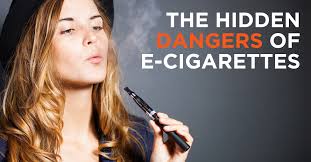
Parents are becoming more alert to the dangers of vaping, and are increasingly concerned, as word spreads about the ways in which young people are especially vulnerable to the lures and hazards of vaping.
A battle is raging in public health circles, in different parts of the world. The controversy is essentially between regulation of vaping based on health dangers, and framing it as a way to stop smoking or as a substitute for smoking, even for teenagers. In fact, Public Health England currently holds the position that vaping (as inhaling aerosols from electronic devices is called) should be regarded as a quit-smoking aid, similar to nicotine patches. In contrast, the Welsh Government is working to restrict e-cigarettes, because the present generation is nearly smoke-free, and vaping may make smoking acceptable and normal again.
E-cigarettes are battery-operated devices that heat liquids and allow users to inhale aerosols containing nicotine and/or other substances that come in many shapes and sizes. The liquid they vaporize varies even more—in flavor, strength, and variety of ingredients. According to the American Lung Association, at present there are very few ways for anyone other than the manufacturers to know what chemicals are contained in e-liquids. Effects on the lungs are for the most part unknown, although one kind of e-liquid ingredient, diacetyl, is established as causing a kind of cancer called “popcorn lung.” In addition, the “vapor” is actually an aerosol, which contains fine and ultrafine particles that tend to lodge in the lungs. Other agencies in the U.S. also take this concern seriously, including governmental agencies such as the U.S. Food and Drug Administration (FDA).
According to the FDA website, “In 2016, the FDA extended its authority to regulate all products that meet the definition of a tobacco product, including: E-Cigarettes and all other Electronic Nicotine Delivery Systems (ENDS), Dissolvables, Pipe Tobacco, Hookah Tobacco, Cigars, as well as Novel and Future Tobacco Products.”
Getting closer to home, California law defined e-cigarettes and e-liquids as tobacco products starting on June 9, 2016. Among other things, this means that retailers now must obtain licenses to sell e-cigarettes, and may not sell them to anyone less than 21 years of age. (This was part of a package of anti-tobacco bills including Assembly member Jim Wood’s leadership to raise the smoking age from 18 to 21 statewide).
In Mendocino County, e-cigarettes and other devices have become visibly popular, especially among young people. Once noticed, the “vapers” seem to be everywhere.
According to the Centers for Disease Control and Prevention (CDC), use of e-cigarettes among high school and middle school students has surpassed current use of every other tobacco product overall nationwide, including conventional cigarettes. Current e-cigarette use (use on at least 1 day in the past 30 days) among high school students increased from 4.5 percent in 2013 to 13.4 percent in 2014, rising from approximately 660,000 to 2 million students.
Science will offer a more thorough understanding of the short and long term health effects in the future. However, today’s young people are not waiting to use nicotine products until all the facts are available; young people need educators and parents to learn about the topic and help them make sound decisions. Otherwise, by the time the facts are in, the youth will already have had a long run of inhaling aerosols and possibly damaging their lungs, and they will have a well-established nicotine addiction.
The Mendocino County Tobacco Prevention Coalition is calling on community members to make contact with Judy Judd, the Project Director, at 707-472-2695 and find out how to be involved.
For those struggling with nicotine addiction, resources are available at www.nobutts.org, and California Smokers’ Helpline at 1-800-NO BUTTS. Classes are also offered through local hospitals.
###
Judy Judd holds a Bachelor’s degree in Human Services/Social Services Administration. She has been active in creating community change in Mendocino County since 1980, and is the Project Director for the Tobacco Control Program of Mendocino County Health & Human Services, Public Health Branch.

